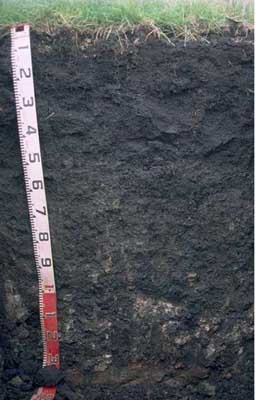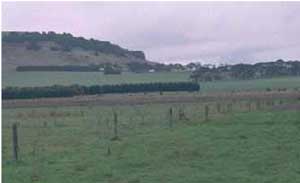SW26
|
| SW26 |  Humose, Calcic, Black DERMOSOL (clayey) | |
| Camperdown | |||
| Level plain | |||
| Quaternary-Newer volcanics (scoria) | |||
Horizon | Depth (cm) | Description | ||
A1 | 0-10 | Black (10YR2/1); light clay; strong medium polyhedral structure; very firm consistence dry; pH 6.7; clear boundary to: | ||
B21 | 10-30 | Very dark grey (7.5YR3/0); light clay; strong medium polyhedral, parting to strong fine blocky structure; firm consistence (moist); pH 7.7; gradual boundary to: | ||
B22 | 30-60 | Very dark grey (10YR3/1); medium clay; strong medium blocky, parting to strong fine blocky structure; very firm consistence (moist); pH 8.5; gradual boundary to: | ||
B23 | 60-100 | Very dark grey (10YR3/1); medium clay; strong medium blocky, parting to strong fine blocky structure; very firm consistence (moist); few (5–10%) calcareous nodules and soft segregations; pH 8.8; gradual boundary to: | ||
B24 | 100-130 | Very dark grey (10YR3/1); medium clay; common (20%) calcareous nodules and soft segregations; pH 8.7; abrupt boundary to: | ||
C | 130+ | Volcanic ash deposits. | ||
| Management considerations | ||||
| Shallow topsoils (generally 10 cm or less) have a reduced water holding capacity limiting root growth and are more susceptible to waterlogging (assuming a clay subsoil), water and wind erosion. Given the limited resource of shallow topsoil, protection and enhancement are very important as well as the need to improve drainage of the subsoil (if affecting the topsoil by limited water and gas movement, therefore restricting root development). Alkaline subsoils are associated with a high nutrient capacity but result in an imbalance in nutrient availability (may be restrictive to certain plant species (eg. potatoes). These soils are often associated with sodic and calcic soil properties. Growing alkaline tolerant species is a practical option. Calcium carbonate nodules (segregations, soft and hard) are associated with alkaline soils. This secondary lime is often found in deep subsoils of many basalt-derived soils. As well as growing tolerant species, some micronutrients may be required to bolster essential macronutrients for more adequate plant growth (e.g. zinc). | ||||
Analytical data
Site SW26 | Sample depth | pH | EC | NaCl | Ex Ca | Ex Mg | Ex K | Ex Na | Ex Al | Ex acidity | FC (-10kPa) | PWP (-150kPa) | KS | FS | Z | C | |
Horizon | cm | H2O | CaCl2 | dS/m | % | cmolc/kg | cmolc/kg | cmolc/kg | cmolc/kg | mg/kg | cmolc/kg | % | % | % | % | % | % |
A1 | 0-10 | 6.7 | 0.4 | 0.4 | N/R | 19 | 11 | 1.7 | 1 | N/R | N/R | 63 | 37.2 | 8 | 15 | 17 | 44 |
B21 | 10-30 | 7.7 | 0.38 | 0.38 | 0.04 | 19 | 18 | 4.8 | 2.8 | N/R | N/R | 64.2 | 39.6 | 3 | 14 | 32 | 39 |
B22 | 30-60 | 8.5 | 0.79 | 0.79 | 0.09 | 16 | 21 | 6.8 | 4.7 | N/R | N/R | 70.4 | 42.5 | 1 | 7 | 24 | 57 |
B23 | 60-100 | 8.8 | 0.4 | 0.4 | 0.03 | 13 | 18 | 6.5 | 2.7 | N/R | N/R | 60.5 | 38.2 | 1 | 5 | 22 | 54 |
B24 | 100-130 | 8.7 | 0.37 | 0.37 | 0.02 | 13 | 16 | 5.4 | 2.3 | N/R | N/R | 0 | 34.3 | 1 | 6 | 10 | 57 |



